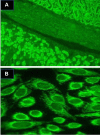Antimitochondrial Antibodies: from Bench to Bedside
- PMID: 34586589
- PMCID: PMC8480115
- DOI: 10.1007/s12016-021-08904-y
Antimitochondrial Antibodies: from Bench to Bedside
Abstract
Anti-mitochondrial antibodies (AMA) are directed against the E2 subunits of the 2-oxo acid dehydrogenase complexes (PDC-E2) and are the typical biomarkers of primary biliary cholangitis (PBC), being present in 90-95% of patients, with increasing sensitivity at increasing titers. Albeit being highly specific for PBC diagnosis, AMA can be detected in less than 1% of healthy subjects, and thus the management subjects with no sign or symptom of liver disease is still a challenge and data concerning clinical risk of developing PBC in this subgroup of patients are controversial. Moreover, AMA can also be detected in patients affected by overlap syndrome, as well as hepatic diseases (i.e., NASH and viral hepatitis), while the association with autoimmune diseases, in particular Sjögren's syndrome, systemic sclerosis, and systemic lupus erythematosus, is well established. Furthermore, new associations are being identified with inflammatory myositis and heart disease. AMA are directed towards the pyruvate dehydrogenase multi enzyme complex (PDC-E2) subunit, which represents an epithelial specific autoantigen for PBC. This review focuses on the main characteristics of AMA, their association with autoimmune diseases and liver diseases.
Keywords: Autoimmunity; Myositis; Primary biliary cholangitis; Systemic sclerosis.
© 2021. The Author(s), under exclusive licence to Springer Science+Business Media, LLC, part of Springer Nature.
Conflict of interest statement
The authors declare no competing interests.
Figures


References
-
- Bogdanos D-P, Pares A, Baum H, Caballeria L, Rigopoulou EI, Ma Y, et al. Disease-specific cross-reactivity between mimicking peptides of heat shock protein of mycobacterium gordonae and dominant epitope of E2 subunit of pyruvate dehydrogenase is common in Spanish but not British patients with primary biliary cirrhosis. J Autoimmun. 2004;22(4):353–62. doi: 10.1016/j.jaut.2004.03.002. - DOI - PubMed
Publication types
MeSH terms
Substances
LinkOut - more resources
Full Text Sources
Medical

